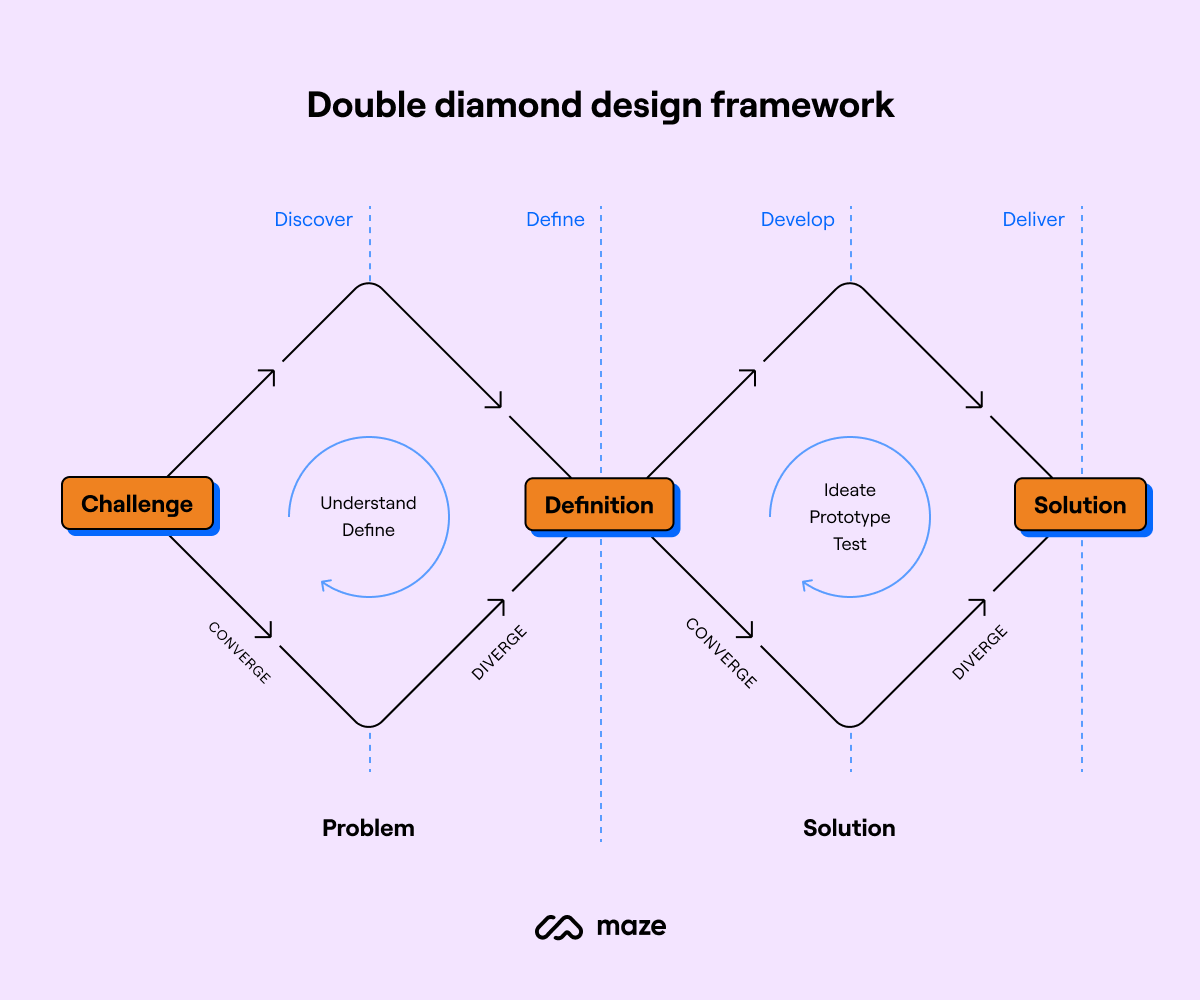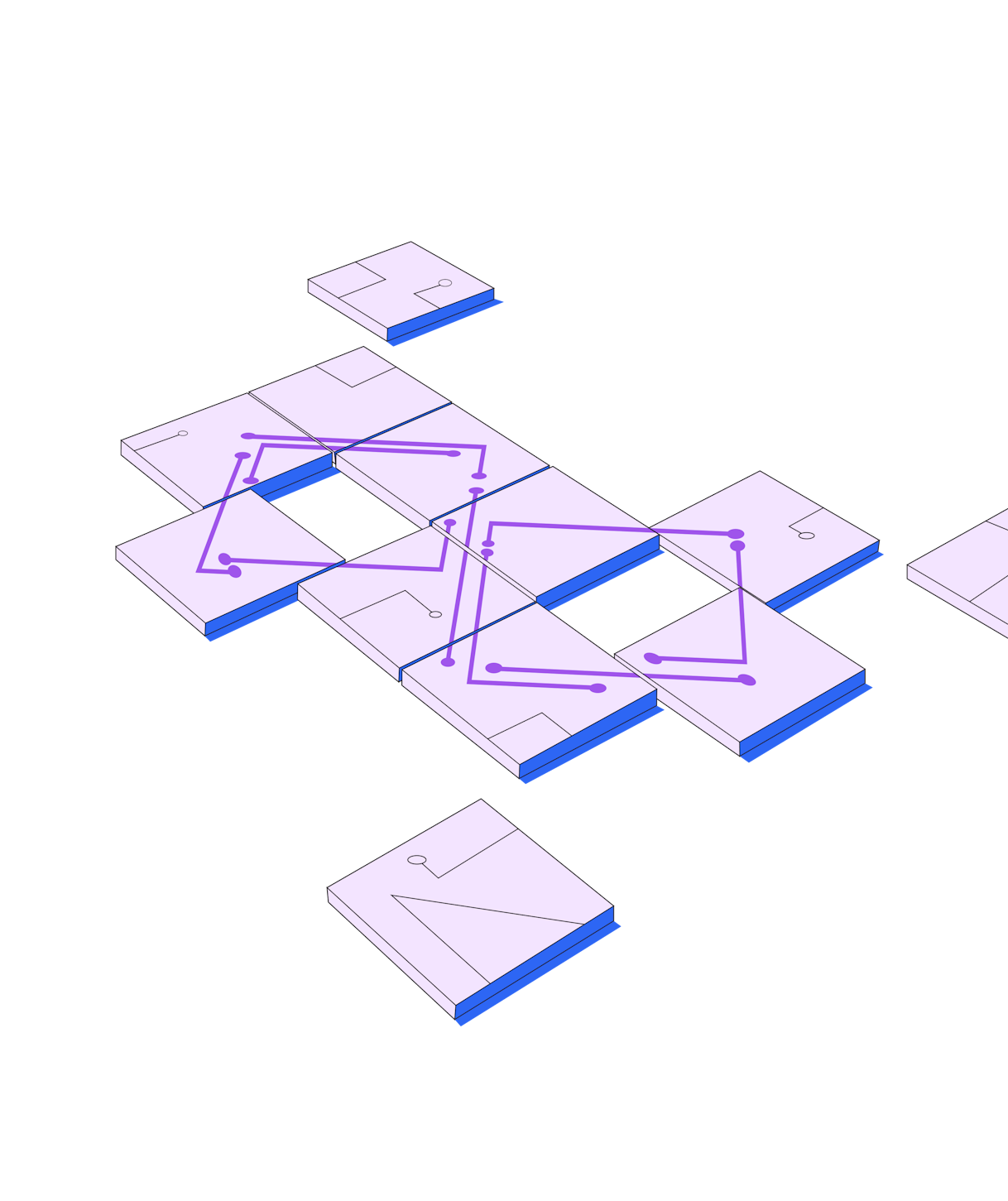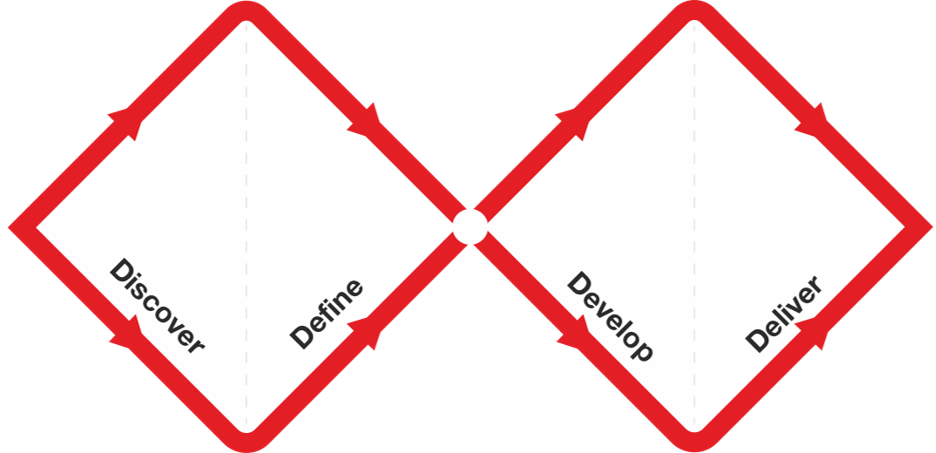Created by the British Design Council in 2005, the Double Diamond design process prioritizes clarity, creativity, and iteration.
In this article, we cover the four phases of the Double Diamond framework, and how you can use this innovative process to stay agile and creative as user needs evolve.
What is the Double Diamond design process?
The Double Diamond design process is a structured UX design framework built on four phases (discover, define, develop, and deliver).

Used in design thinking to guide teams from problem identification to solution delivery, the Double Diamond design process helps designers and UX teams tackle complex design challenges, like understanding user needs and pain points, generating and testing multiple ideas, and ensuring a user-centered approach.
The Double Diamond process helps in UX design by guiding teams through the UX design process with a structured, iterative approach to product discovery, idea generation, concept testing, and solution validation.
Here’s how it supports UX research across all phases:
- Discover: UX researchers gather user insights through interviews, surveys, and observations to identify pain points and needs
- Define: Researchers synthesize the gathered data into a clear problem statement to guides design focus
- Develop: The team brainstorms and prototypes potential solutions, testing these with users to refine the ideas
- Deliver: The final, tested solution is implemented and launched, with ongoing user feedback collected to ensure it meets user needs
A brief history of the Double Diamond design framework
The earliest record of this framework for innovation dates back to the 1960s, when Alex F. Osborn and Sidney Parnes developed the Creative Problem Solving (CPS) process. The model was further documented and developed by Béla H. Bánáthy’s 1996 work, ‘Designing Social Systems in a Changing World’, which looked at how divergent and convergent thinking are crucial to Design.
The Double Diamond model we know and use today was popularized by the British Design Council in 2005, and has since been further developed to address global challenges and integrate a holistic approach to design.
What is divergent and convergent thinking in the Double Diamond?
Each ‘diamond’ represents a phase of divergent thinking (exploring many possibilities) and convergent thinking (narrowing down to the best solutions), making it a powerful framework in the design process. In short, the first diamond looks at the problem, and the second diamond looks at the solution.
Divergent thinking encourages creativity and open-mindedness, allowing for innovative solutions to emerge. Convergent thinking is about making decisions, refining ideas, and concentrating on what is most effective and feasible.
What are the four steps of the Double Diamond process?
The Double Diamond process is divided into four key phases that guide the product development process, taking you from problem statement to tried-and-tested solution.
Step 1. Discovery: Explore, research, and gather information
The discovery phase is the first step in the Double Diamond process, where the focus is on deeply understanding the problem at hand. This involves identifying issues and uncovering challenges.
Start by asking broad, open-ended user research questions to guide your exploration:
- What are the users’ pain points?
- What are the root causes of these problems?
- Who are all the stakeholders, and how are they impacted?
User research is the backbone of the discovery phase. It’s about collecting qualitative and quantitative data to form a full picture of the problem.
You can collect data using UX research methods like:
- User interviews: Open-ended interviews let you gather rich, qualitative insights about user experiences, frustrations, and needs
- UX surveys: Surveys provide quantitative or qualitative data, identifying trends and patterns across a broader user base
- Field studies: Sometimes called ethnographic research, field studies give you organic insights into how user interact with products or systems in real life
- Competitive analysis: Analyze how other companies address similar problems to set benchmarks, highlight gaps in the market, or identify opportunities for innovation
Once you’ve gathered your data, you need to identify patterns, cluster related information, and refine your understanding of the problem. Use affinity mapping to organize your data into clusters based on common themes. This helps identify the core issues that need addressing.
Finally, document all your insights, data, and conclusions from the discovery phase. Now is the time for your UX research repository to come into its own!
💡 Pro tip
Remember to keep stakeholders updated! Regular check-ins and collaborative workshops build stakeholder buy-in and ensure everyone is aligned.
Step 2. Define: Refine and understand the problem
The definition phase is when you take the broad range of insights gathered during the discovery phase and narrow them down to a clear and actionable problem statement. The problem statement developed in this phase will guide all subsequent design efforts, so it needs to be clear, focused, and actionable.
A well-crafted problem statement should:
- Clearly define the problem your users are facing
- Explain the impact this problem has on your users (reference your research insights)
- Be specific and actionable in what parts of the product need to be addressed
For example, if you’re looking to optimize a CRM platform, you might find during the discovery phase that many clients are struggling with reporting features—they’re too advanced for users’ actual use cases, and require manual data entry which is time-consuming. This is leading to poor feature adoption.
A reflective problem statement could be:
"Clients find it difficult to generate reports with our CRM tool due to the complexity of the reporting features and amount of manual work needed, resulting in low adoption rates. The product needs to be simplified with intuitive, easy-to-use reporting features that allow users to quickly create customized reports without extensive training or data entry."
Step 3. Develop: Ideate potential solutions
The development phase is all about ideation, prototyping, and refining possible solutions to address the problem statement.
To start, you want to generate as many ideas as possible. This involves:
- Brainstorming sessions: Encourage the team to think creatively and come up with as many ideas as possible, without worrying about feasibility—the focus is on quantity, not quality
- Collaborative workshops: Involve cross-functional teams—including the design team, developers, and stakeholders—to contribute different perspectives and expertise so the ideas generated are diverse and well-rounded
Once a broad range of ideas have been generated, the next step is to start turning some of these ideas into tangible prototypes for testing. The aim is to quickly visualize ideas and make them tangible enough for testing before you decide on a single solution.
This involves:
- Creating low-fidelity prototypes: These are simple versions of the product or feature, such as sketches, wireframes, or basic models
- Iterative resting: Begin prototype testing to understand what works, what doesn’t, and why—this iterative process allows the team to refine ideas quickly and efficiently
During the Develop phase you might find yourself exploring different prototypes, going back to the drawing board to pick up a previous idea, or pivoting in your approach to the solution. For maximum efficiency, use a UX research tool that integrates with prototyping tools, so you can streamline the design to research UX workflow, and move back-and-forth as needed.
For example, with Maze your team can easily import interactive designs using integrations with Figma and Sketch.
Remember, by the end of the development phase, your team should have a clear, well-tested solution that is ready to move into the final phase of delivery.
Step 4. Deliver: Finalize and implement the chosen solution
This phase is all about bringing the refined and tested solution to life, so it effectively addresses the problem defined earlier in the process. This involves:
- High-fidelity prototyping: Create detailed, high-fidelity versions of the solution that are as close to the final product as possible—this might include polished designs, fully-developed software, or complete physical models
- Usability testing: Conduct testing with real users to validate the final solution and ensure the product meets user needs in real-world scenarios
As with the previous phase, this step can be cyclical. Practice continuous product discovery, gather feedback, and make adjustments as needed.
Once your winning solution is finalized, the next step is to implement and launch it:
- Production: This involves final coding, integration, and preparing the software for deployment
- Marketing and communication: Create promotional materials, launch advertising campaigns, and engage with potential users through various channels
- Training and support: Ensure users have the support they need to successfully adopt the new solution—this could mean creating user manuals, providing training sessions, or setting up customer support services
After the solution has been delivered, it’s essential to monitor its performance. Set up key performance indicators (KPIs), like user adoption rates or customer satisfaction scores, to measure the success of the solution.
Remember: The delivery phase doesn’t necessarily mark the end of the design process. Often, the feedback and data collected post-launch will highlight areas for iterative updates (which can also be approached using the Double Diamond design process).
How to use the Double Diamond in UX research: An example
Let’s walk through an example of how a fictional platform called ‘WorkSync’ could apply the Double Diamond design process to improve its user experience.
WorkSync is a platform that helps large companies manage remote workforces, offering features like time tracking, project management, and performance analytics.
The challenge the WorkSync team faces is that HR managers, who rely heavily on the platform’s reporting features, are frustrated with the difficulty of generating and customizing reports.
Phase 1: Discover
Objective: Understand the pain points HR managers face with the current reporting features.
Activities:
User Interviews: The UX team conduct in-depth interviews with HR managers from 10 of their largest clients. They ask questions like:
- How often do you use the reporting tool, and for what purposes?
- What challenges do you face when customizing reports?
- What external tools do you rely on to fill the gaps in our reporting system?
Outcome: Through these interviews, the team identifies that HR managers struggle with limited customization options in the reporting tool, often leading them to use external tools for data analysis.
Note: This is a simple example, but typically, businesses will conduct mixed methods research to maximize the breadth and depth of their customer insights.
Phase 2: Define
Objective: Synthesize insights into a clear, actionable problem statement.
Activities:
- Affinity mapping: The team organizes the feedback into key themes like ‘customization challenges’ and ‘external tool dependency’
- Problem statement: The team formulates the problem statement: HR managers want a more flexible and intuitive reporting tool within WorkSync that allows easy customization and eliminates the need for external software
Outcome: The problem statement is documented and shared with the design and development teams to align everyone on the challenge to be addressed.
Phase 3: Develop
Objective: Generate, prototype, and test potential solutions.
Activities:
- Brainstorming: The design team generates ideas, such as a drag-and-drop report builder, customizable templates, and real-time data filtering
- Prototyping: Low-fidelity wireframes are created, featuring the drag-and-drop builder and customizable templates
- User testing: These prototypes are tested with a select group of HR managers and feedback is gathered on the ease of use, relevance of the new features, and any remaining pain points
- Synthesizing: The team perform user research analysis to assess their current prototype
Outcome: Based on user feedback, the prototypes are refined into high-fidelity designs that are more user-friendly and directly address the identified issues.
Phase 4: Deliver
Objective: Finalize and implement the solution, then monitor its success.
Activities:
- Final development: The development team builds the final version of the reporting tool, incorporating features that best address the problem
- Rollout and training: The new tool is rolled out with detailed training sessions, webinars, and updated documentation to support HR managers during the transition
- Monitoring and feedback: After launch, the team monitors how the tool is being used, tracks adoption rates, and collects feedback through follow-up surveys
Outcome: The new reporting tool is widely adopted, with HR managers reporting improved efficiency and a reduction in the need for external tools, validating the success of the solution.
Run the Double Diamond process with Maze
Creating a successful, user-centered product isn’t just about great ideas—it’s about making sure those ideas work for the people who will use them. Investing in understanding and implementing structured frameworks like the Double Diamond process helps your team systematically explore and refine solutions, so your final product truly meets user needs.
Ultimately, testing and refining your designs are at the heart of creating your products.
With a user research platform like Maze, you can conduct Feedback Surveys, User Interviews, Prototype Testing, and more to identify issues and research solutions. Once you’ve finished testing, Maze generates Automated Reports with all the key details—so you can get insights at a glance.
The best products are the ones that meet user needs. A structured approach, like the Double Diamond design process, and a powerful research tool, like Maze, is how you build them.
Frequently asked questions about the double diamond design process
What's the difference between design thinking and the Double Diamond design process?
What's the difference between design thinking and the Double Diamond design process?
Design thinking involves five key stages:
- Empathize
- Define
- Ideate
- Prototype
- Test
The Double Diamond mirrors this by guiding teams through divergent and convergent thinking—first exploring a wide range of ideas and then refining them into the best solutions. The Double Diamond essentially visualizes the stages of design thinking, making the process more structured and easier to follow.
What are the four Ds of design?
What are the four Ds of design?
The four Ds of design refer to the phases in the Double Diamond design process:
- Discover: Research and gather insights to understand the problem
- Define: Analyze the insights to clearly define the problem
- Develop: Generate and prototype potential solutions
- Deliver: Finalize and implement the best solution to meet user needs
What is the systemic design framework?
What is the systemic design framework?
The systemic design framework is the British Design Council’s development and expansion of its earlier Double Diamond framework. It’s a mindset and a methodology that acknowledges the complexity and interconnectedness of design challenges, and social challenges as a whole. The systemic design framework urges designers and non-designers to consider the wider context of their designs and the impact they have in the modern world we live in.






